| |
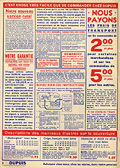 |
|
| |
 Dupuis
Frères, Spring/Summer Catalogue, 1934, p. 2. Dupuis
Frères, Spring/Summer Catalogue, 1934, p. 2.
|
|
| |
|
|
|
Read the Fine Print: How the Postal Service Served the
Mail-order
Industry
by Gaëtanne
Blais
The Post Office serviced the mail-order industry in
many ways:
by shipping catalogues and merchandise and offering various fee schedules;
by
issuing money orders and postal notes so that customers could pay for
their merchandise
by mail; and, by collecting money on cash-on-delivery orders. The
mail-order
houses responded and adapted in their own ways.
Introduction | How the
Mail-order
Business Fit with the Postal Service | Paying for the
Order
| Shipping the Merchandise | Free
Shipping
| Using Local Postage Rates | Shipping
Perishables
| Returning Merchandise | Conclusion
|
Further Reading
Introduction
The Canadian Postal Museum (CPM) has collected various objects related
to
the sale of merchandise by mail, including mail-order catalogues, order
forms,
envelopes for sending order forms, samples, postal notes, and money
orders. Such
objects are significant as they illustrate the importance of the postal
service
in making a wide variety of merchandise available to all Canadians,
especially
in rural areas. Through an examination of documents from the collection
dating
back to the 1930s, a view of the relationship between the Post Office
department
and mail-order houses emerges. The Post Office department earned revenue
from
mail-order houses; mail-order houses sold a wide variety of goods, and
customers
had access to goods not available locally. Everyone benefited. Yet, there
is
evidence of tension.
How the Mail-order Business Fit with the Postal
Service
Mailing to the Customers
Mail-order catalogues and merchandise fell into two mail matter
categories: third-class
mail and parcel post. Third-class mail included newspapers and periodicals
as
well as books, pamphlets, circulars, and catalogues. Thus, catalogues and
samples
could be mailed at lower rates.
| |
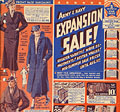 |
|
| |
 Army
and Navy Expansion Sale Catalogue, 1937, cover. Army
and Navy Expansion Sale Catalogue, 1937, cover.
|
|
| |
|
|
|
|
The Post Office department facilitated the shipment of catalogues
through
arrangements "whereby the prepayment of postage on such matter may
be effected
in cash (instead of by postage stamps) … Each article must have
printed
upon its wrapper or cover an impression of one of the official stamps
provided
for the purpose." A permit and an electrotype
("electro") bearing
the name of the post office, the permit number, and the amount of prepaid
postage
had to be obtained from the postmaster. Such arrangements could only be
made
at larger post offices in cities where mail-order houses were established
and
"where there is a system of checking and accounting which fully
protects
the postal revenue."
|
|
The shipment of samples was described in a category of its own. The
Canadian
Postal Museum's samples fit the Post Office department's
guidelines
in terms of size and weight limits and contents that were "not of
saleable
value." However, there is no mention in the guidelines for
or
against the use of the envelope as a marketing tool, which was
clearly
Eaton's intention. The graphics are attractive and the text goes
beyond
"such words as may be necessary to indicate precisely the origin and
nature
of the merchandise."
|
| |
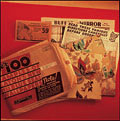 |
|
| |
 Packet
and samples, Eaton's Wallpaper Book, 1933. Packet
and samples, Eaton's Wallpaper Book, 1933.
|
|
| |
|
|
|
|
Parcel Post was used for shipping "farm and factory products
…
dry goods, groceries, hardware, confectionery, stationery, … seeds,
cuttings,
bulbs, roots … and all other matter not included in the first class,
and
not excluded from the mails by the general prohibitory regulations with
respect
to objectionable matter." As mail-order houses shipped large numbers
of
parcels of varying weights and sizes, they had to inform themselves of the
numerous
parcel post regulations and rates (25 regulations described over 13 pages
in
the 1933 Official Postal Guide).
But, calculating the correct amount of postage to include could be
daunting
for the customer. What if a person did not want the
"buy-for-$5.00-and-we-pay-the-shipping-charges"
deal? Then, an "amount allowed for charges" had to be enclosed
with
the order. Or, when buying seeds from Eaton's, a customer had to
determine
which merchandise was "price delivered" (whereby Eaton's
paid
the delivery charges) and which was not. Could everything be ordered and
shipped
at once to save on charges? A chart of distances and weights was used to
determine
what was owed for shipping merchandise so that Eaton's could
determine
how much could be subtracted for their part of the charges.
Proximity to the Post Office or Railway
Some details on order forms and envelopes appear insignificant
until
they are examined in light of postal guidelines. To order wallpaper, for
example,
the customer had to include his or her name, the name of the closest post
office,
a street name, the rural route or post office box number, and the
province. A
customer's street address was insufficient.
A post office name was required by Eaton's and other mail-order
houses
to make sure the merchandise was delivered to the right person and to
establish
whether money-order service and train service were available. Thus, the
order
form in Eaton's wallpaper catalogue asks: "Is there an agent
at your
station? How many miles do you live from the station?"
Such factors were important especially when shipping fragile items:
"There
are certain post offices in Canada, situated on Railway Lines which are
served
by what is known as 'Catch Post Service' only, as the mail trains do not
stop
there. In these cases the mailbags are taken on and thrown off moving
trains,
and it has been found impossible to handle fragile parcels
satisfactorily."
Paying for the Order
| |
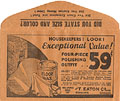 |
|
| |
 Order-form
envelope, Eaton's Wallpaper Book, 1933. Order-form
envelope, Eaton's Wallpaper Book, 1933.
|
|
| |
|
|
|
|
When ordering from a mail-order house, customers could pay using money
orders
or postal notes. The amount could be sent with the order form or paid by
Cash
on Delivery (COD). Money orders and postal notes were highly recommended
by Dupuis
Frères as they were cheap and perfectly secure. Eaton's also
encouraged
these methods of payment and reminded its customers on the order form
envelope:
"Did You Enclose Money Order?"
|
| |
 |
|
| |
 Money
order. Money
order.
|
|
| |
|
|
|
To ensure the popularity of this service in the eyes of mail-order
companies
and consumers, these modes of payment had to be practical and secure.
Money orders
could be issued in amounts up to $100, the limit on a single money order.
Multiple
money orders of $100 could also be purchased. They were a safe way of
sending
money. In case of loss, a duplicate could be obtained.
| |
 |
|
| |
 Postal
note. Postal
note.
|
|
| |
|
|
|
Whereas money orders were used for larger orders, postal notes were
used for
smaller ones, from 10 cents to $5. As with money orders, postal notes
could be
traced and duplicates issued. Eaton's further emphasized in its 1938
seed
catalogue that money orders and postal notes "prevent loss and
protect
all concerned."
| |
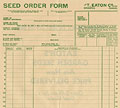 |
|
| |
 Seed
order form, Eaton's Seeds Catalogue, 1938. Seed
order form, Eaton's Seeds Catalogue, 1938.
|
|
| |
|
|
|
Money orders and postal notes facilitated the purchase of merchandise
by being
readily available to customers. In addition, there was money to be made by
the
Post Office department. In the fiscal year ending March 31, 1934, a total
of
11 790 068 money orders worth $101 926 368.91,
generated
gross revenues of $1 462 016.60. A total of 5 115 761 postal
notes
were issued worth $9 247 458.65 and generated revenues of
$114 308.02.
Shipping the Merchandise
Cash on Delivery (COD)
Once an order was prepared, the mail-order house could ship by
Cash
on Delivery (COD).The postmaster or mail contractor (if in a rural area)
was
responsible for collecting the payment from the customer and returning it
to
the mail-order company.
| |
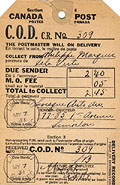 |
|
| |
 COD
tag, 1931. COD
tag, 1931.
|
|
| |
|
|
|
|
|
| |
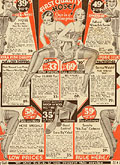 |
|
| |
 Army
and Navy Bankers' and Manufacturers' Liquidation Sale Catalogue,
Fall/Winter
1932-33, p. 2. Army
and Navy Bankers' and Manufacturers' Liquidation Sale Catalogue,
Fall/Winter
1932-33, p. 2.
|
|
| |
|
|
|
|
Army and Navy offered this service somewhat offhandedly, "We ship
COD
if you request this service," while Dupuis Frères did not
recommend
it because, they said, it was more costly for the customer and could cause
delays.
The Post Office department charged a commission for the service, which
was
passed on to the customer. In 1933-34, the COD fee schedule was as
follows:
"15 cents if the amount to be collected is not more than $50.00; 30
cents
if the amount to be collected is more than $50.00; limit of collection,
$100.00.
The fee must be paid by means of postage stamps affixed to the article by
the
sender [i.e., the mail-order house], and is additional to the ordinary
postage."
|
| |
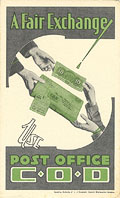 |
|
| |
 An
advertisement for Cash on Delivery. An
advertisement for Cash on Delivery.
|
|
| |
|
|
|
|
Although not all post offices in Canada were "accounting"
or money-order
post offices, rural post offices were and thus could obtain COD service.
In 1933-34,
the Post Office department handled approximately 1 709 304 COD parcels
that generated
$256 395.60 in fees, an average of $6 per collection. These fees added up.
Oblivious
to the opinion of the mail-order houses, the Post Office department pushed
COD.
|
Free Shipping
As a further means of enticing customers, mail-order houses offered to
pay
shipping charges on orders of a certain amount, thus encouraging the
customer
to spend more, without necessarily increasing shipping charges for the
company:
"We pay shipping charges on all orders of $5.00 or over. If your
order
does not amount to $5.00 you can make it up to this amount with items from
our
General Catalogue."
Army and Navy offered to "pay postage or express charges on every
order
big or small." This incentive was repeated on every second page in
their
1932-33 catalogue, and was still available in 1937. In addition to
free
shipping charges, Army and Navy offered gifts on orders "ten dollars
or
more." Dupuis Frères made shipping a bit more complex.
Delivery
was paid on orders of $2 or $5, but only on certain items. Read the fine
print!
In its 1938 seed catalogue, Eaton's offered to pay delivery
charges
(although not on parcels shipped Air Mail or COD) on all the garden seeds
marked
"Price Delivered." This meant Eaton's paid for mail
delivery
to the nearest post office (thus the requirement for the name of the post
office
on the order form) or to the nearest railway station for larger orders.
Delivery
Charges were extra on "Field Seeds, Seed Potatoes, Rose Bushes,
Onion Sets,
Bulbs, Roots, Plants and Fertilizers." As these items were
perishable and
probably ordered in such quantities and weights to require special
treatment:
"Be sure to see your Station Agent regarding the Special Low Freight
Rate
on Farm Seeds."
Eaton's also shipped by airmail upon customer request, but would
only
pay the standard parcel postal rate on items for which it accepted to pay
delivery
charges. Customers had to: "Make inquiries from your postmaster as
to Air
Mail Rates, and be sure to enclose sufficient money to pay the extra Air
Mail
Charges." In all cases, Eaton's kept to its guideline:
"We
reserve the right to ship the cheapest way."
Using Local Postage Rates
Throughout the 1920s and 1930s, tensions over postage costs grew
between
the Post Office department and the mail-order houses. To keep postage
costs down,
Eaton's and other mail-order houses shipped their parcels to
distribution
centres using their own fleets of trucks or express companies (transport
by truck
or train). Once at these centres, parcels were mailed to customers using
low,
local postage rates.
This was against Post Office department guidelines, as expressed in the
filed
correspondence: "Mail order houses have again made application to
ship
their parcels of merchandise part way by fast freight and then mail them
for
distribution at the lower parcel post rates … [W]e have always
compelled
mail order houses to mail their parcels of merchandise at the natural
office
of posting … paying the full parcel post rates covering transmission
by
post all the way. We have always taken the stand that to grant them the
special
concession which they ask … would be an infringement of the pledge
given
to country merchants when parcel post was inaugurated [in 1914]."
Very noble sentiments, indeed. In 1932, the Post Office department was
earning
"$3 500 000 per annum from mail-order houses for conveying
their
parcels by post."
Shipping Perishables
Although not a complaint against the post office or the railway
service,
Eaton's felt it was necessary to warn customers against shipping
perishables
at certain times of year: "Please note that we cannot ship Seed
Potatoes,
Onion Sets …during the cold weather on account of the danger of
freezing.
Orders received at a time when, in our opinion, it is unsafe to ship on
account
of frost, will be held, together with remittance (including postal
charges) until
is safe to ship."
Returning Merchandise
| |
 |
|
| |
 Instruction
sheet, Eaton's Wallpaper Book, 1933. Instruction
sheet, Eaton's Wallpaper Book, 1933.
|
|
| |
|
|
|
To avoid merchandise returns, Eaton's made sure its customers
understood
the merchandise. For example, in its 1933 wallpaper catalogue, detailed
instructions
were included. Nevertheless, Eaton's provided customers with a
"Goods
Satisfactory or Money Refunded" guarantee: "[I]f you are not
perfectly
satisfied, return what you have left and we will refund the money you paid
for
the entire lot, including shipping charges." (It's not in the
fine
print but the customer had to pay the cost of returning the goods.) When
an order
was delivered COD, customers were not permitted to examine the parcel
before
paying the charges, nor could they give back the parcel and request a
refund:
"[T]he COD service does not carry with it any examination privilege
…In
the event of the addressee having paid the charges due on a COD article,
and
after examination of the same desiring to hand the article back, and have
the
money refunded, such request is under no circumstances to be complied
with."
Conclusion
The documents examined here were produced by Eaton's, Army and
Navy,
and Dupuis Frères, and are a testimony to manoeuvring on the part
of both
the Post Office department and the mail-order houses. Although the
relationship
between two was not always amicable and had its inconveniences, it was
beneficial
to both partners.
Everything possible was done by the mail-order houses to ease the
shipping
process for their customers, at the lowest possible cost to themselves.
Not surprisingly,
subtle advertisements for free shipping and free gifts must have been
powerful
incentives during the Great Depression of the 1930s.
To shore up its relationship with the Post Office department,
mail-order houses
took out ads thanking the Post Office employees. One such ad celebrated,
unfettered,
the spirit of co-operation with which postmasters processed mail-order
merchandise.
Yet, other ads, while thanking postmasters for their good work, also
served as
reminders to the postal service of its responsibility to maintain a good
relationship.
The handling of catalogues was an incremental part of the mail-order
process.
Postmasters at the mailing end would receive large quantities of circulars
and
catalogues (bundles of 50, 75, and 100). These had to be counted and
weighed
and the postage checked. Postmasters at the receiving end had to comply
with
postal regulations and with the mail-order houses when items were
addressed "Householder,"
or had to be redirected or returned due to non-delivery, etc.
So, by quoting the Postal Guide in this last ad, the Robert Simpson
Company
Ltd. had a very effective argument, characteristic of this relationship
-
it required the Post Office department to read its own fine print!
Further Reading
Canada Official Postal Guide, 1933. Ottawa: Post Office
Department,
1933.
National Archives of Canada, RG13, Justice, Series A-2, Volume 368,
file 1932-740,
"Post Office Department - Proposed Evasion of Higher Parcel
Post
Rates by Mail Order Houses."
Report of the Postmaster General for the Year Ended 31 March
1934.
Ottawa: Post Office Department, 1934.
|